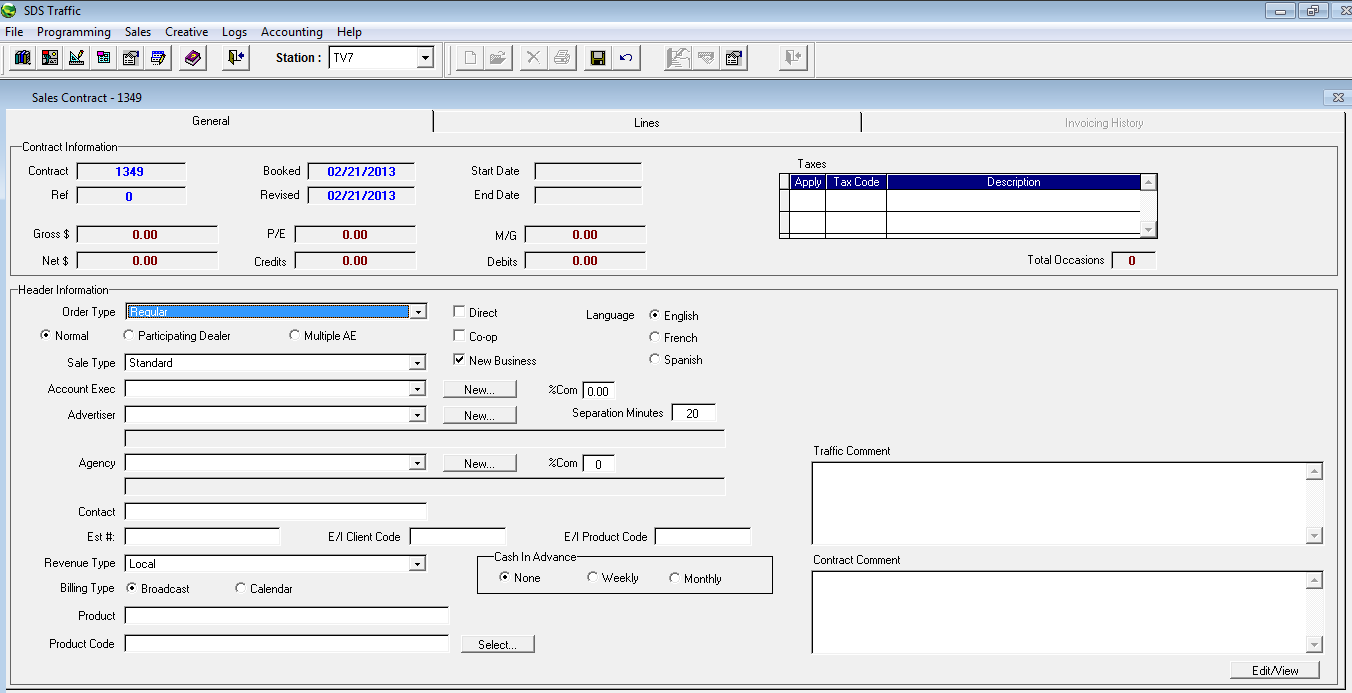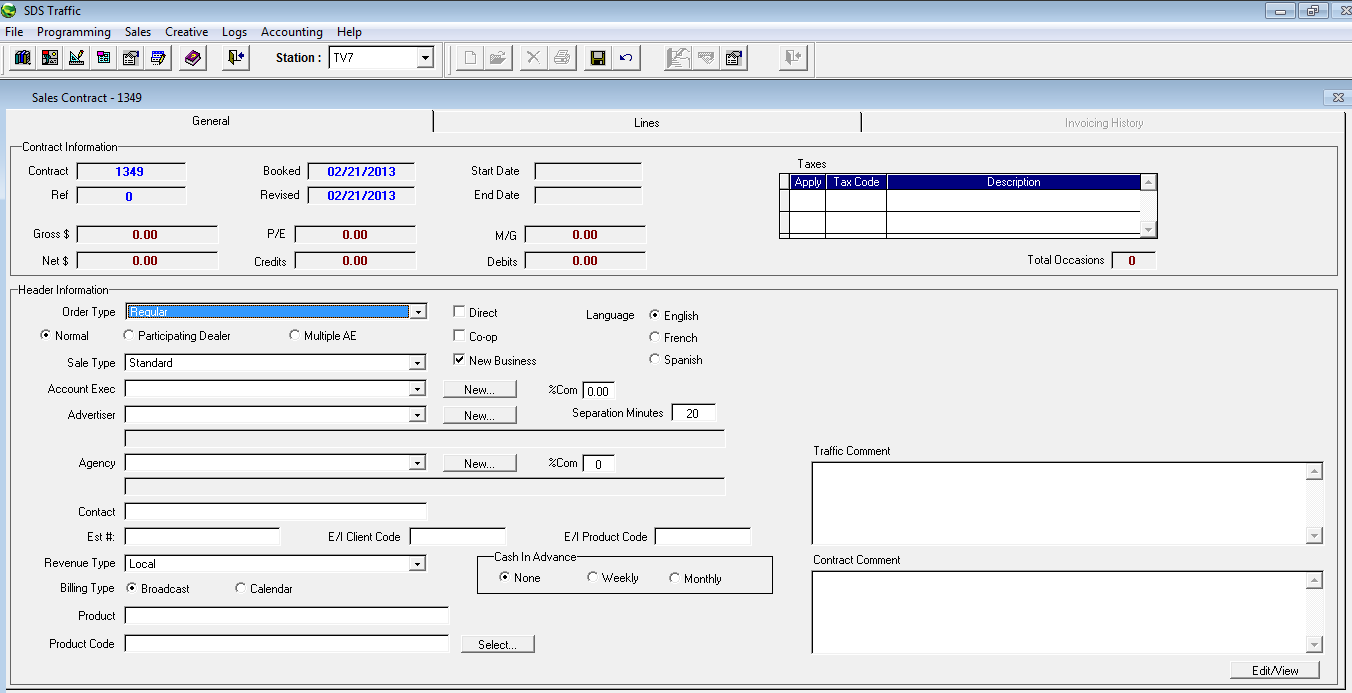

Contract # - this will display the contract number assigned. This can be automatically assigned by SDS, or user assigned
Ref # - this field will be filled in if the contract originated from SDS Sales. If it originated from Traffic, it will always be blank
Booked – this is the date that it was entered into the system
Revised – this is the date that the last revision was made to the contract
Start Date/End Date – the start and end date of the contract
Gross – the gross total of the contract
Net – the net total of the contract
P/E – the total value of pre-emptions on the contract
Credits – the total value of credits on the contract
M/G – the total value of make goods on the contract
Debits – the total value of debits on the contract
Total – the total amount of the contract
Total Occasions – the total number of spots on the contract
*Note - When entering the Agency or Advertiser, if Taxes have been associated with the Agency/Advertiser, these taxes will appear in the Taxes field. For more information on Taxes in Sales Contracts see the section “Applying Taxes to Sales Contracts”
Order Type
There are a few options to select from the drop down – these are system set and not user definable:
Regular – choose this when building a regular order
Per Inquiry or P.I – A form of marketing in which the advertiser receives free ad time and space while paying only for results. The advertiser gives up control of where and when the ads will run
Header - Type of In House contract. The only difference is that the print option is bypassed when saving the contract. The contract can still be printed using the Sales Contract Printing area of SDS
Open Contra – select this when building a Trade/Contra order. By choosing this as the order type, it will denote on the invoice for the client to not remit a payment
Commitment – Used when the advertiser agrees to spend a certain amount of money. The first line of the contract must be type “UNS” (Uninstructed). The system then subtracts each line after the “UNS.” The contract will keep track of
the amount remaining. Note that this is a Traffic only function, and cannot be set up in SDS Sales.
Suppressed - Selecting this order type will conceal the rate per spot on each line of the contract, and only the grand total of the contract will appear
Direct Response - Direct Response and Per Inquiry are similar. The difference is that the advertiser knows where the spot will run, so that the call centre can be ready to respond
In House – A way to track in house (station) contracts such as a promotion or a public service announcement
Normal - this is the default and simply means that it is not a part dealer or a multiple AE contract
Participating Dealer – each advertiser pays a certain percentage of the campaign and receives an invoice
Multiple AE – the contract can have multiple reps. When this option is selected, the revenue will be distributed evenly, and the commission will be shared
Direct – check mark this if there isn’t an agency involved
Co Op Contract - multiple advertisers will have separate invoices
New Business – check mark this if the client is considered new business and needs to be tracked as such
Language – choose from English, French or Spanish (the language will be reflected on the sales contract printout)
Sale Type – this gives the ability to add in additional information for tracking purposes (Christmas Package, Spring Fling, etc)
Account Exec – choose the Account Executive (Sales Rep) from the drop down. This is user defined through the main Traffic screen
%Com- the Account Executive commission will default based on the rep selected from the pick list if a default commission has been entered, however this can be changed by entering in the desired value.
Advertiser –choose who the client is from the drop down. If the advertiser is direct, then the address of the advertiser will appear in the field below. If the advertiser is being billed to an agency, this field should be empty
Separation – this indicates the advertiser separation level for this contract between the spots on this contract (minimum is 5 minutes, maximum is 240 minutes)
Agency – choose the agency from the drop down. The address of the agency will appear in the field below
Commission (%) Agency - the agency commission will default based on the agency selected from the pick list, however this value can be changed by entering in the desired value (no decimals);
Contact – this field is optional. Enter in the name of the person you are dealing with at the advertiser or agency
Est # (Estimate number for agencies)/P.O # (Production Order number) – This field is optional. It is a maximum of 10 characters due to standardized rules for Electronic Invoicing.
E/I Client Code – this is an 8 character field, and this information is provided by the agency for Electronic Invoicing purposes (fields will only appear if an agency has been selected). If the agency is not using DDS, the field can be 8 characters long
If the agency is using DDS for Electronic Invoicing, the following rules must be adhered to:
•The estimate field should contain a number between 1 and 250
•The agency client code should contain a 2 or 3 character alpha-numeric code. The first two characters must be alpha or a number from 1 to 5, the third may be alpha or a number from 0 to 9, or it may be blank
E/I Product Code - this is an 8 character field, and this information is provided by the agency for Electronic Invoicing purposes (fields will only appear if an agency has been selected). If the agency is not using DDS, the field can be 8 characters long
If the agency is using DDS for Electronic Invoicing, the following rules must be adhered to:
•The agency product code should contain a 2 or 3 character alpha-numeric code where the first character must be alpha, the second and third characters can be alpha or a number from 0 to 9, or the third character can be blank. DDS agencies cannot use NO, ZZZ, ALL, YES, UNA, or AAA as valid products
Revenue Type (Income Accounts) – choose from the drop down – this is user defined through the main Traffic screen
Billing Type – select Broadcast or Calendar – this will indicate how the client will be billed – based on the broadcast month, or calendar month
Cash in Advance – choose from None, Weekly, or Monthly. A few notes on this feature
•If the contract is a participating dealer, the cash in advance feature is not available
•If you are not using SDS AR, the cash in advance feature is not available
•There are 3 settings to choose from (found in the System Settings)
o Do Nothing – the log can be exported without any warnings
o Warn User before exporting the log – “The following contracts are cash in advance, but payment has not been received. Do you wish you export the log?”
o Warn and prevent the log from exporting – “The following contracts are cash in advance, but payment has not been received. The log cannot be exported until the spots are removed from the log, or the payment has been received”
Product – this is the name of the campaign
Product Code – this is the ‘conflict code’ to identify what type of product the advertiser is. This will default to what is at the advertiser level, but can be changed by clicking on the Select button
Traffic Comments – these comments will appear on the printout of the contract
Contract Comments – when saving a contract, the following message will appear.

If you click Yes, a new box will appear where you can enter in comments that will appear only internally. Once the comments have been entered, the system will keep track of who entered them, and when. These will remain Read Only Comments
Entering New Comments

Entering Additional Comments to the contract

**These comments can be viewed on screen, or by clicking the View/Edit button at the bottom of the screen. If you are a Symphony client, this information also transfers over to the Sales side and can be viewed by clicking a similar button in the Header Information screen.